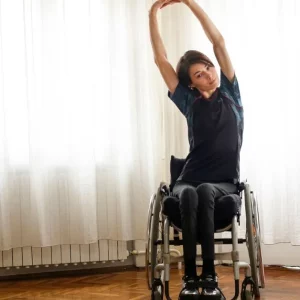After a spinal cord injury, survivors may experience changes in sensation such as numbness and/or tingling below the level of injury. While this can raise concern, tingling after a spinal cord injury can sometimes be a sign of recovery. Changes in sensation should be taken seriously though, because numbness or tingling in the body can increase the risk of autonomic dysreflexia, a potentially dangerous condition.
This article will discuss what causes changes in sensation after spinal cord injury, how it can sometimes be a sign of recovery, and effective management techniques.
What Causes Tingling and/or Numbness After Spinal Cord Injury?
Loss of sensation is one of the most common secondary effects of spinal cord injury. When we touch or feel something, sensory information travels through the spinal cord to the brain. After this information is processed, the brain then sends signals back down to the body. These signals from the brain often stimulate a movement-based reaction, such as moving away from a hot stove.
However, when a spinal cord injury interrupts this process, it can be difficult for sensory information to reach the brain to be processed and responded to appropriately. When this occurs, individuals may experience complete loss of sensation below the level of injury. Alternatively, individuals may retain some sensation, but it may be impaired, causing tingling or altered sensations (paresthesia).
When a loss of sensation occurs, it is often referred to as numbness. Many people report feeling numbness after a spinal cord injury, since the nerves responsible for sending sensory signals to the brain are often damaged or disrupted.
The inability to process sensory stimuli can make it difficult to protect your body from any potentially harmful stimuli. Therefore, complete or partial loss of sensation after a spinal cord injury can increase the risk of further injury.
While this can be concerning, the presence of tingling after spinal cord injury is not always a negative sign. Let’s take a look at what impaired sensation after spinal cord injury could mean.
What Does Tingling After Spinal Cord Injury Mean?

When a survivor begins to feel tingling after spinal cord injury, it can actually be an indicator that at least some sensory communication exists. Thus, tingling in the arms or legs after spinal cord injury can be viewed as a positive sign of recovery because it shows that at least some sensory stimuli is reaching the brain.
While complete numbness may indicate a more serious condition, tingling in certain parts of the body below the level of injury can indicate that the neural pathways in that muscle are being restored – which is great news for recovery!
Restoring sensation, movement, and function following a spinal cord injury is heavily dependent on the level of injury, intensity of rehabilitation, and whether the injury was complete (spinal cord fully severed) or incomplete (spinal cord partially severed). Usually, individuals with incomplete spinal cord injuries have higher chances of recovery because there are unaffected neural pathways within the spinal cord remaining.
In fact, tingling is only possible with an incomplete SCI, because complete SCI survivors have no feeling below the level of injury. Therefore, it’s important to continue training the areas where you may feel even the slightest sensations to maximize the chances of recovering sensation.
Through specific therapies, you can help strengthen the spared neural pathways in the spinal cord that relay sensory information to the brain. Thus, if you are experiencing tingling in your affected limbs after an incomplete SCI, try to think of it as a sign of hope for recovery.
Managing Changes in Sensation After Spinal Cord Injury

Different types or rehabilitation methods can help minimize numbness and tingling after spinal cord injury. It’s important to note that these are management techniques that can help with the symptoms, but they may not address the root cause.
Management techniques for numbness after spinal cord injury can include:
Avoiding Triggers for Autonomic Dysreflexia
Survivors who experience loss of sensation after a spinal cord injury (especially those with a T-6 level injury or higher) are at risk of developing autonomic dysreflexia. This is a condition in which the autonomic functions of the body overreact or produce involuntary actions.
Individuals with autonomic dysreflexia after a spinal cord injury may experience:
- Abnormally high blood pressure
- Irregular heart rate
- Severe headaches
- Nausea or vomiting
- Difficulty breathing or chest pain
Numbness after an SCI can increase the chances of triggering autonomic dysreflexia because it becomes more challenging for individuals to notice sensory stimuli below the level of injury, such as a full bladder or tight clothing.
Therefore, understanding and avoiding potential triggers is essential to lowering the risk of autonomic dysreflexia. This can include wearing loose clothing, avoiding extreme temperatures, evacuating your bladder regularly, checking catheters, and inspecting the skin routinely for pressure sores and bruises.
Safety Tips
If you are experiencing numbness after spinal cord injury, being aware of your surroundings can help you stay safe and prevent further injury. As previously mentioned, loss of sensation can put you at a greater risk for potentially harmful stimuli. Therefore, it’s important to keep the following safety tips in mind:
- Keep a lookout for sharp objects
- Be extra careful when cooking and minimize the use of stoves, microwaves, or any other household appliance
- Use a thermometer to check the temperature of shower or bath water (the safest temperature is 100°F), and lower the hot water heater temperature to no higher than 120°F
- Reposition yourself or ask a caregiver to assist you in repositioning often (at least every 2 hours) to lower the risk of pressure sores or ulcers.
Pressure sores are a common result of impaired motor control and sensation. This is because sensation provides the urge to move after being in one position for a prolonged time, and motor control allows the body to move. When either function is impaired, the skin becomes vulnerable to ulcers. Thus, it’s extremely important for you or a loved one to ensure your body is frequently moved.
Maximizing Neuroplasticity, Especially in Early Recovery

During the first 6-9 months after injury, the spinal cord enters heightened levels of neuroplasticity, the central nervous system’s ability to rewire itself. Neuroplasticity allows existing neural pathways in the spinal cord to be strengthened and new pathways to be formed, allowing for better communication between the brain and body. The better the communication, the more the brain will be able to receive sensory information and process that stimuli, potentially reducing tingling and/or numbness.
Large improvements may initially be seen through “spontaneous recovery,” but a plateau in gains often occurs about 12-18 months post injury. However, this does not mean recovery completely stops. It continues as long as rehabilitation is pursued actively. Rehabilitation can include a variety of therapies and management techniques, which is crucial to maximize the chances of full recovery after spinal cord injury.
Sensory Reeducation
When individuals with incomplete spinal cord injuries begin to feel some sensation returning, sensory reeducation can help stimulate neuroplasticity. Sensory reeducation typically involves stimulating areas of affected sensation with items of differing textures. Rubbing the affected area with the hand, a soft blanket, or a washcloth can provide differing inputs to help stimulate communication within the nervous system.
Sensory reeducation techniques may be utilized with the eyes open or closed, and may also include attempting to localize a sensation to a certain area of the body. Consult with your occupational therapist to learn more about sensory reeducation.
Acupuncture
Though there is minimal research available for its effectiveness in specifically treating numbness and tingling, studies have shown that acupuncture can help relieve neuropathy, which includes weakness, numbness, and pain from nerve damage (commonly felt in the hands and feet). Some individuals with numbness after spinal cord injury may also experience neuropathic pain, making acupuncture an attractive way to help manage symptoms.
In fact, studies showed that SCI survivors who received one treatment of acupuncture daily for 6 days had significant reductions in pain and numbness. A more targeted approach is known as electroacupuncture where a small electric current is passed through pairs of acupuncture needles. While electroacupuncture usually focuses on improving movement after SCI, it can potentially help with sensation, especially if your injury was incomplete. The best way to find out is to try, just be sure to consult with your doctor or therapist beforehand.
Electrical Stimulation
Lastly, a management technique that may help with numbness and tingling after spinal cord injury is electrical stimulation. There are many different types of electrical stimulation available, and it’s essential to talk to your therapist to discuss which options are suitable for you. They can also provide any necessary training on how to use an at-home e-stim device.
For example, during Transcutaneous Electrical Nerve Stimulation (TENS), electrodes are placed on the surface of the skin to stimulate the muscles and nerves. While no studies have directly found a link between TENS and numbness after spinal cord injury, the option could be worth exploring to help stimulate neuroplasticity. TENS has also been shown to help with neuropathic pain.
Understanding Numbness & Tingling After Spinal Cord Injury
Many survivors experience numbness and tingling after spinal cord injury. While loss of sensation can raise concern and increase the risk of autonomic dysreflexia and other complications, tingling may actually be a sign of recovery. Tingling indicates that there is at least some neural activity remaining, which increases the chances of recovery through neuroplasticity.
Talk to your therapist to discuss which options are most suitable for you, such as electrical stimulation or electroacupuncture. We hope this article helped you understand tingling and numbness after spinal cord injury, and the most effective management techniques to overcome these effects.











